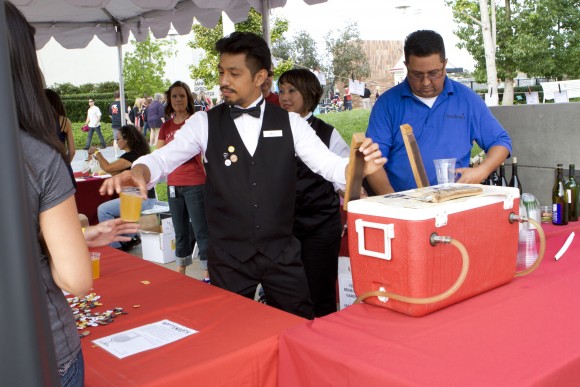
Pulp and Fish Bladders: The Science of the Protein Isinglass in Our Beer No one wants pulpy beers, but do we also want to drink protein from a fish bladder?
October 2, 2015
In light of Homecoming this week, we asked Food Science students to talk about some of the wonderful treats offered at the event. Among them would be beer, and this year we’re very excited to not just have any beer but a specifically a Chapman Panther Brew, specially created for the day by Bottle Logic owner and brew master Steve Napolitano ’03. Steven Rogers, a Food Science student, provided us an interesting analysis of what we’re actually DRINKING when we drink beer and how it might change in the future. Purchase tickets for this weekend on the merchandise page provided in the Homecoming online registration form.
With the fall season starting we’ve finally arrived at a time of falling leaves, orange and red colors, and pumpkin spiced, well, everything. It also marks the only time multiple American professional sports leagues converge and coexist. Come October every sports bar across the country will be playing NFL games that are finally getting interesting, NHL games that are just warming up, NBA games finishing up through pre-season, and MLB games on their postseason tour to the World Series.
Of course, these sports bars will be serving a lot of beer. Cold, beautifully amber-colored beer. Straight from the tap or poured from the bottle. Or maybe you’re the type to chug your beer straight form the open top of the bottle with the cap freshly popped off, there’s no judgement here. All that really matters is that it is available, especially at those glorious scoring moments by the home team displayed on the dozens of TVs around the bar, and that it is good. A good beer, golden throughout until you get to that thin foam layer on the top.
Every sip, or chug, is pure, clean, and smooth. Smooth because the beer was probably made from initial wort to final product with the clean look in mind the entire time. When the beer is sitting in the glass on the bar between you and that World Series game, all you see is the wonderful, all encompassing, fluid amber color. What you don’t see is the steps within all of the processing that took to make the beer. Why is that? Because all of the part of the beer that isn’t supposed to exist by the time you drink it has been filtered out and removed.
Pulp? In My Beer?
Imagine you’re sitting at the bar, it’s game seven of the World Series, your team just pulled in a big home run, and, to celebrate, you grab a brew. What you find is an off-brown, grainy mixture of solid and liquid handed to you. At first you suspect the glass is simply dirty as there are even brown flecks spotted in the normally pristine foam, but then you notice the clumps are actually floating around inside the not-quite-beer. A swirling mass of crud rising and falling as the carbonation moves the undesired particles around in a dance of disgust. Just taking a sip from this would-be beer imposter would definitely cause your team to get steam-rolled in the finale of the Series.
Bartender, I ordered my beer pulp free, thank you.
Yet, this chaos in a beer glass may be a possibility if people like Vani Hari, aka the “Food Babe,” have their way with changing how beer is made. Of course I’m being (slightly) hyperbolic, our beer will never reach pulp-like levels, but it may lack the smooth distinction that one expects with beer. Why would this be the case? An incomprehensible attitude to one of the fining ingredients used in beer production: Isinglass. Hari calls into question the use of isinglass, despite acknowledging that it reduces the haziness of beer and clears it of solids and other fermentation byproducts, by inaccurately implying you’d actually be consuming it in the final product.
Isinglass and Fish Bladders
For those that don’t know what isinglass is, it is a protein isolated from the swim bladders of certain fish. Of course to Hari this means we’re consuming actual fish while we drink the nectar of the gods in front of a live streaming baseball game. Rest assured, the next time you grab a glass of Guinness, the most widely known beer to use isinglass as a fining agent, you will in fact not be consuming fish bladder. If for some reason isinglass did make it into the final product, which due to its use is exceptionally rare, it’ll be in virtually zero quantities.
Why am I so sure about this? Because studies have been done to show how much isinglass is actually present in the final brew product. Baxter and others showed all the way back in 2007 that isinglass levels in common ales, lagers, and stouts were almost nonexistent. Testing 13 beers against a control, isinglass-free beer, they measured isinglass levels at an average of less than 1 mg per liter of beer. It might as well be nonexistent. Not all breweries do a final filtration step as it has the potential to ruin the taste of the final product. Using a fining agent, something that will bind to the yeast particles and some of its more unsavory byproducts to sink them all to the bottom of the barrel, thus creating a clean pure concoction above, is necessary in crafting the perfect beer.
Drink and Be Merry!

Sure, the idea of using something derived from a fish to make good beer sounds odd. Mixing hops with mashed up barley to enhance yeast’s ability to ferment the sugars? Sounds natural to me. What about some fish bladder protein isolate to get rid of the yeast after?
Wait, what?
The thing is, it works and it makes your beer taste magnificent. Criticizing beer for having an ingredient that actually isn’t even present in the final product seems a little odd. No one criticizes cheese production for needing rennet to curdle the milk, yet that also comes from the stomach of an animal, a cow in this instance. Likewise, the processing aid rennet is not found in the final product. In the end, most beers on the market don’t use isinglass or gelatin, another animal-derived fining agent. However, when consuming a beer that did use it in production, don’t worry about drinking blended fish bladder, you literally aren’t. Now whether that makes these beers vegetarian or vegan friendly is an entirely different topic. Drink some beer, watch the game, and enjoy the coming fall weather.


